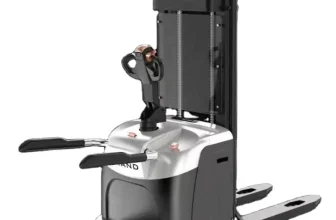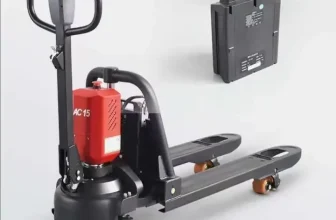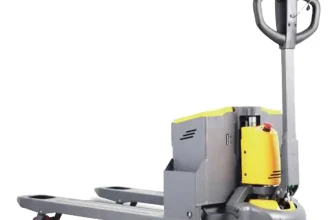A pallet jack, also known as a pallet truck, pallet pump, pump truck, or jigger, is a tool used widely in warehouses and industries to lift and move pallets. Comprising of a small, low platform set on wheels, it has a handle that the operator uses to jack up the forks and slide them under the pallet. When the forks are raised, the pallet can be moved with relative ease. By using simple hydraulic principles, a pallet jack makes heavy lifting task safer and more efficient.
Importance of Pallet Jack Safety
Pallet jack safety is a critical consideration for any operations involving the manipulation and transportation of goods. The importance of safety cannot be overstated because it not only ensures the well-being of the workforce, but also enhances efficiency and productivity in the warehouse or distribution center. The improper use of pallet jacks can swiftly lead to severe injuries, equipment damage, and loss of valuable inventory. According to the U.S. Bureau of Labor Statistics, thousands of employees suffer injuries involving pallet jacks each year. By understanding and applying safety procedures, these accidents can be significantly mitigated, creating a safer workplace environment.
Understanding Pallet Jacks
Types of Pallet Jacks
Pallet jacks come in a variety of styles to suit different applications. Most commonly, they’re divided into two broad categories: manual and electric.
- Manual Pallet Jacks: These are the most basic form of pallet jacks, primarily used for moving heavy or bulky items short distances within a warehouse or retail floor setting. Their operation is purely mechanical with a hydraulic system to elevate the forks. Cost-effective and simple to use, they require human power to push, pull, and steer, which limits their utility to lighter loads and shorter distances.
- Electric Pallet Jacks: For larger warehouses or heavier loads, electric pallet jacks are the preferred option. They’re either power-assisted for transportation or fully powered for both lifting and moving. Electric pallet jacks often include features like throttle control, a braking system, and a built-in charger. These pallet jacks are designed to lessen operator fatigue, enhance efficiency, and increase safety but are more expensive than manual variants.
There are subtypes too, including all-terrain pallet jacks for rough surfaces, scissor pallet jacks featuring a built-in lifting mechanism, and low-profile pallet jacks for handling special low-clearance pallets. The choice of pallet jack depends on your specific requirements including the type of terrain, load weight, and the frequency and distance of haulage.
Basic Parts of a Pallet Jack
A pallet jack, also known as a pallet truck, pallet pump, pump truck, or jigger, is a tool used to lift and move pallets or heavy loads in warehouses and stores. All pallet jacks have some fundamental parts that enable them to function properly.
- Handle: This is the control center of the pallet jack, featuring various controls to operate the equipment. It allows the operator to raise, lower, and steer the pallet jack.
- Forks: These are the two long flat structures that slide into the pallet to lift and transport it.
- Hydraulic Pump: This component is the heart of the machine. When the handle is pumped, the hydraulic pump lifts the forks, hence the pallet off the ground.
- Wheels or Rollers: They can be found on the rear and front side of the pallet jack. Rear wheels located on the forks help with lifting and transporting, while the front wheels assist in steering.
- Lever: This part controls the up and down movement of the pallet jack. It typically includes three positions: lifting (raise), neutral (neither raise nor lower), and lowering (lower).
- Load Rollers: These are smaller wheels on the forks’ ends aiding in easy entry and exit from the pallet.
Understanding these basic parts of a pallet jack is critical in ensuring its proper use and maintenance, thus enhancing safety in the workplace.
Operational Limits
Pallet jacks, like all industrial equipment, have operational limits that users must understand and adhere to ensure safety and longevity of the equipment. These limits revolve around weight capacity, the terrain on which the unit operates, the temperature conditions, and the speed at which it is used.
One of the primary operational limits to be aware of is the weight capacity. Overloading a pallet jack beyond its limits can result in damage to the equipment and create a safety hazard. Each pallet jack has a maximum load capacity, usually indicated on the jack itself, typically ranging between 2,500 and 5,500 pounds.
It’s also important to consider the terrain. Pallet jacks are designed to run on smooth, flat surfaces. Uneven terrain can cause instability, leading to tipped loads or an unstable operation.
Temperature conditions too seem to bear an impact. While pallet jacks can generally function in a wide range of temperatures, extreme cold or heat may affect functionality. Hydraulic components, for instance, might not operate properly in excessively cold conditions.
As for speed, it is vital to operate a pallet jack at a secure and controlled speed to avoid accidents. Quick or sudden actions lead to instability, especially when the pallet jack is loaded.
Remember, understanding and respecting a pallet jack’s operational limits isn’t just crucial for safety—it also extends the lifespan of the equipment.
Pre-use Inspection
Importance of Pallet Jack Inspection
Inspection of a pallet jack before every use is crucial in preventing accidents or mishaps at the workplace. It allows operators to determine the operational status of the equipment, ensuring it’s functioning optimally before loading. A faulty pallet jack can pose serious safety risks, leading to damage to goods, injury to staff, or even worse, severe accidents.
Moreover, a regular inspection routine ensures the longevity of the machinery. Identifying and addressing wear and tear or damages early on can help keep the equipment in good condition. Additionally, inspecting the pallet jack can help identify potential problems before they escalate, reducing maintenance costs in the long run.
Under standards and regulations put forth by OSHA, companies are required to maintain their equipment, including pallet jacks, in a safe operating condition. Regular inspections, therefore, form a critical part of ensuring compliance with these standards, and non-compliance could lead to penalties.
Overall, pre-use inspection of a pallet jack is a simple but effective way to ensure not only the safety of the operator but also the efficiency and productivity of operations.
List of Items to Check
Every driver is responsible for their pallet jack’s adequate performance to ensure not only personal safety but also the safety of colleagues and the integrity of the goods being moved. Hence, it’s important to run a comprehensive pre-use inspection of the equipment:
- Wheels and Tires: Look for evidence of wear and tear or cracks. Make sure the wheels roll smoothly without any hitches.
- Handle: The handle should move easily from one position to other with the appropriate resistance. Check for any visual defects or parts that might be loose.
- Forks: Check the forks for any evidence of bending or other deformities, which might compromise the ability of the pallet jack to lift and move loads. Ensure the forks are of equal length and evenly spaced.
- Hydraulic System: Look for any leaks in the system. Test the lifting mechanism to ensure it functions smoothly and reliably. Ensure that there is enough oil, and it is clean.
- Safety and Operational Equipment: Make sure that all brakes, horns, and safety devices are functioning correctly.
- Pallet Jack Body: Check for any signs of damage or wear, such as rust or bent sections of the frame, which might undermine the equipment’s strength.
Remember, these checks should be performed before every use. An issue with any of these parts dramatically increases the risk of an accident. Therefore, ensuring thorough pre-use inspection is an essential element of safe pallet jack operation.
When to Report Issues
Anyone operating or working near a pallet jack should immediately report any issues they notice, irrespective of how minor they might seem. Early detection not only mitigates the risk of a minor defect turning into a major problem, but also ensures the safety of all the workers in the vicinity. The most common signs that point to a potential problem with a pallet jack include: difficulty in maneuvering the equipment, hydraulic fluid leaks, abnormal noises, unsteady or erratic movements of the load, and broken or missing parts. Such problems should not be ignored or fixed by ad-hoc methods, but should be immediately reported to a supervisor or the in-charge of pallet jack maintenance. In the eventuality that the equipment’s condition poses immediate danger, evacuate the area and prioritize the safety of personnel.
Safe Operation Procedures
Understanding Load Capacity
Load capacity is a critical factor to understand in the safe operation of pallet jacks. It refers to the maximum amount of weight that a pallet jack can safely carry. Overloading pallet jacks not only damages the equipment but also poses serious safety risks, such as tip-overs, which can cause injury to operators and bystanders alike.
Before using a pallet jack, the first step is to inspect the nameplate or owner’s manual to find out its load capacity. This information is typically located on a decal or plate on the device; it indicates the maximum weight load recommended by the manufacturer. It’s imperative not to exceed this limit under any circumstance.
While loading the pallet jack, ensure that the weight is evenly distributed across the forks. An unbalanced load can cause the pallet jack to become unstable, increasing the chance of an accident. It’s important to note that just because material fits on the forks, doesn’t mean it’s within the safe load capacity.
In summary, understanding a pallet jack’s load capacity is an essential part of safety procedures. Always be aware of the maximum load capacity of the equipment, distribute the load evenly, and never exceed its capacity to ensure the safety of all individuals involved.
Instructing on Safe Lifting Techniques
While a pallet jack is designed to do the heavy lifting, operators may still have to handle some loads manually. Therefore, understanding safe lifting techniques is essential. The most important rule is never trying to lift anything too heavy. If it’s too hefty, ask for assistance or divide the load into smaller, more manageable parts.
The safe lifting process begins with planning the route. Make sure the path towards the destination point is clear of any obstacles. Next, position yourself close to the load. The closer it is to your body, the less strain it puts on your back and the rest of your body.
When you’re ready to lift, bend at your knees, not at your waist, maintaining a straight spine. This is because the power for heavy lifting comes from your legs and not from your back. Make sure your grip is firm and that you’re lifting slowly, with a smooth and controlled motion.
Once the load has been lifted, keep it as close to the body as possible. If you need to turn, turn by moving your feet, not your torso, to avoid straining your back.
When putting the load down, use the same principles—bend your knees and keep your waist and back straight. Never twist or lean sideways when setting the load down.
Remember, improper lifting techniques can lead to serious injuries. Awareness and training are crucial components of avoiding accidents. Following these simple techniques will ensure your safety in the workstation.
Guidelines for Moving a Loaded Pallet Jack
Moving a loaded pallet jack requires special attention to safety. Always plan the route before starting, making note of any obstructions, inclines, declines, or slippery surfaces. Ensure the load is stable and balanced before the move.
Take the following steps while moving a loaded pallet jack. First, ensure all personnel are clear of the route. Stand at the tiller and push the control handle down to lower the forks. Lift the load and begin moving only when you have confirmed that the path is clear.
Always push the jack, rather than pulling it, to avoid foot injuries and maintain better control. Move at a safe, steady speed to prevent tipping, and make turns slowly, as abrupt direction changes can upset the stability of the load.
Do not attempt to stop the pallet jack suddenly. Instead, slow down gradually before coming to a complete stop. Be particularly vigilant while moving downhill—with the extra momentum, it may be more difficult to slow or halt the jack.
Always start and stop gradually to avoid jerking movements which might destabilize the load or the pallet jack. If you have to move across an incline, proceed sideways instead of up or down, to prevent the jack from tipping over.
Remember, your own safety and the safety of those around you should always be a priority while operating a pallet jack.
Parking and Storage Safety
Parking a pallet jack properly after use is essential to ensure the safety of all employees on the floor. Always lower the forks of the pallet jack to the ground when it’s parked. Leaving forks in an elevated position can cause tripping hazards or damage to the equipment. If the pallet jack is not in use, it should not block any passage or emergency exit. Make sure it’s parked in a designated area.
Storage safety is crucial to increase the lifespan of the equipment and maintain its efficiency. Avoid leaving pallet jacks in areas exposed to rain, snow, or excessive heat. Instead, store them in a dry, cool place away from the elements.
Any loaded pallet jacks should be carefully stowed. Ensure the loads are properly rested and not overhanging that could cause potential hazards. Remember, a properly parked and stored pallet jack not only ensures the safety of the workforce but also helps in maintaining the equipment in good working order.
Safety Precautions
Wearing Appropriate Personal Protective Equipment
Personal Protective Equipment (PPE) is a vital component in ensuring your safety when operating a pallet jack. The type of PPE needed may vary depending on the working conditions and tasks to be performed, but generally, workers should be equipped with steel-toed boots to protect feet from accidental drops of heavy loads or a runaway pallet jack.
Non-slip or anti-skid gloves provide a better grip and help prevent hand injuries when manually maneuvering the equipment. In case the work environment is quite noisy due to the movement of the pallet jack and other machinery, proper ear protection such as earmuffs or ear plugs could be deemed necessary.
Visibility aids like high-visibility vests are particularly useful in busy warehouses or in low-light conditions, as they make the operator highly noticeable to others, helping avoid accidents.
Top it off with hard hats in working environments where there’s risk of falling objects. Remember, PPE should fit properly and be comfortable enough for long-term use, as ill-fitting equipment can limit mobility and create additional safety concerns.
Always ensure that the necessary PPE is worn correctly and consistently to reduce the risk of injury. This is an easy yet crucial step to take in making the workplace safer for everyone.
Keeping Work Area Clear and Safe
Keeping the work area clear and safe is an integral part of pallet jack safety. Any obstacles in the path of a moving pallet jack can cause accidents, including tipped loads or even personal injuries. Thus, a clean, organized workplace is crucial.
Firstly, ensure that the floor is free of debris, clean, and dry. Loose items, as well as wet or slippery surfaces, can pose a hazard, leading to unexpected accidents when maneuvering the pallet jack.
Secondly, keep the intended path of travel clear. Prior to moving the jack, visually inspect your planned route to confirm it’s unobstructed. Avoid areas with heavy foot traffic and notify people in the area that you’ll be moving a heavy load.
Lastly, properly position loads in your work area. When not in use, pallet jacks and their loads should be securely stored in designated areas, not in aisles or exit paths. Always keep in mind, an uncluttered environment aids in the safe operation of pallet jacks.
Regular Maintenance and Servicing
Regular maintenance and servicing is a critical element of pallet jack safety. A well-maintained pallet jack is less likely to fail or cause accidents due to equipment malfunction. It’s advisable to establish a regular maintenance schedule, in keeping with the manufacturer’s guidelines. Routine check-ups should include inspection of the wheels for wear and tear, ensuring the forks are undamaged and straight, and confirming the hydraulic system is leak-free and in good working condition.
Servicing should also be carried out periodically by trained professionals who specialize in pallet jack repairs. This can help to identify potential issues before they become major problems, therefore preserving the equipment’s integrity and longevity. By adhering to a robust maintenance and servicing regime, workplaces can optimize the functionality of their pallet jacks and considerably reduce the risk of injury, fostering a safer working environment. Remember, preventive maintenance is always better than expensive repairs following an accident.
Emergency Situations
Steps to Take During an Emergency
If an emergency does arise while a pallet jack is in use, it’s essential to remain calm and respond promptly. The first step is to safely halt the operation of the pallet jack, provided it can be done without risk of further harm. Avoid panicking or making sudden movements which could exacerbate the situation. Next, alert other personnel nearby of the situation to keep them out of harm’s way.
If the emergency involves a spill or a fallen load, ensure that the area is marked off to prevent accidents. Any leaking substance should be immediately contained and cleaned according to the substance’s safety data sheet instructions.
In cases where the pallet jack or operator becomes trapped or injured, do not attempt to move them without professional help, as it could potentially worsen the injury. Instead, signal for medical assistance or call the local emergency number.
Lastly, it’s crucial to report all emergencies, no matter how minor they appear, to a supervisor. This ensures that the event is documented and can be prevented in the future. Make sure to provide a clear and precise account of the incident, including what led to the situation, initiating emergency procedures, and the timeline of events. This will provide invaluable insight into how similar incidents can be avoided in the future.
First Aid Training
Proper first aid training is an essential aspect of handling emergency situations with a pallet jack. Accidents and mishaps can occur despite stringent safety measures in place, and being prepared can make all the difference in responding effectively and potentially avoiding life-threatening injury.
First aid training shouldn’t be confined to just medical personnel within the organization. It’s beneficial for all staff who operate or work around pallet jacks to have at least a basic understanding of first aid techniques. Knowledge on how to administer CPR, treat burns, and manage wounds can be lifesaving in the crucial moments before professional help arrives.
Moreover, first aid knowledge can help prevent minor injuries from escalating into major issues. For instance, correctly handling a sprain suffered during a pallet jack operation can not only provide immediate relief but also avoid long-term damage.
To maintain safety standards high, regular first aid training sessions should be hosted. This will not only reinforce the known procedures but also update employees on any new techniques and protocols that could be beneficial. Integrating such programs into your safety culture emphasizes risk prevention and promotes a more informed, responsive workforce.
In conclusion, first aid training contributes significantly to handling emergency situations. It empowers employees to respond promptly and accurately, potentially saving lives and preventing extensive injuries in the event of an accident involving a pallet jack.
Training and Certification
Requirement for Proper Training
Proper training is an absolute necessity when it comes to operating a pallet jack. It is not just a matter of understanding how the equipment operates, but also about understanding how to use it safely and efficiently. Training should ideally be provided by a professional with experience in using and teaching about pallet jacks.
A standard training program should include a theoretical understanding about the operation of the pallet jack, its parts, limits and safe operation procedures. It should also contain hands-on training where the trainee gets a chance to get familiarized with the equipment under the guidance of a supervisor.
It is also important that the training is not a one-time event. Refresher courses should be taken periodically, or whenever there is a change in the type or model of the pallet jack being used. This ensures that the operator is always up-to-date with the latest safety measures and operational procedures. Regular tests and assessments will also help to keep the operator’s skills sharp and their knowledge current.
Training also extends to the work environment. Operators should be trained to assess their environment for hazards and obstacles, and to react correctly in emergency situations. This will go a long way in preventing accidents and ensuring a safe workplace.
Importance of Certification
Certification for operating a pallet jack is not just formality, but a crucial factor that ensures safety in the workplace. While training provides the technical knowledge and practical skills, certification proves the individual’s competency. Certification acts as a verification that a worker has received appropriate training and illustrates their ability to operate the pallet jack safely.
An authorized certification body assesses the worker’s understanding of the machine’s operational procedures and their ability to respond effectively in emergency situations. Furthermore, it shows that the worker is aware of the safety protocols involved in its operation and can perform essential tasks like pre-use inspections, identifying mechanical issues, and conducting regular maintenance.
Certification can also decrease a company’s liability in the event of a workplace incident as it shows the employer took necessary precaution by ensuring their employees were adequately trained. It instills confidence in the certified operators, empowering them with the knowledge and skills they require to perform their tasks safely and efficiently.
In summary, not overlooking the importance of achieving certification is fundamentally part of ensuring safety in environments where pallet jacks are used. Therefore, all operators should strive to get certified. It is advantageous for both employees and employers, promoting a safer and more productive working environment.
Conclusion
Importance of Safety
Ensuring safety while operating pallet jacks is fundamental. The proper use and handling of these heavy-duty tools helps to prevent work-related accidents and injuries, contributing to a more efficient work environment. Safety measures such as pre-use inspections, understanding load capacity, adhering to safe lifting techniques, and routine maintenance are crucial aspects that can’t be overlooked. Furthermore, it’s important to bear in mind that emergencies can occur unexpectedly, so having knowledge of the necessary measures to take during such situations can save lives and important machinery. In the end, investing in proper training and certification enriches understanding and embraces the culture of safety. These initiatives not only ensure personal safety, but they also protect the integrity of the equipment and maintain high productivity levels. Hence, prioritizing safety should be the norm and not an afterthought.
Implementation of Safety Measures
Ensuring safety in the workplace must always be a top concern, particularly when using equipment such as pallet jacks. Simple efforts in implementing and abiding by safety measures can significantly reduce the potential for injuries and accidents in the workplace. Workers and management alike should foster an environment where proper operation, routine inspections, necessary maintenance, and safety regulations aren’t just practiced but also appreciated. Let’s all remember, safety isn’t just about rules and regulations, it’s about cultivating a work culture that values, respects and prioritizes the safety of everyone on the team. Start making these safety tips part of your daily routine today, not just for your protection but the overall well-being of your entire organization.







